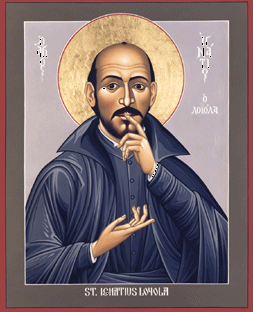 In listening to Pray-as-you-go, meditations focusing on God being with us, a passage was particularly striking to me which I have listened to several times since I first heard it. I found the quote on this site in how Ignatius invites us to picture the world in which we live:
In listening to Pray-as-you-go, meditations focusing on God being with us, a passage was particularly striking to me which I have listened to several times since I first heard it. I found the quote on this site in how Ignatius invites us to picture the world in which we live:(This is a little different than what was said on the meditation as it is more in depth):
St. Ignatius and his first companions, in the spiritual experience of the Exercises, were moved to a searching consideration of the world of their own time in order to discover its needs. They contemplated "how the Three Divine Persons look down upon the whole expanse or circuit of all the earth, filled with human beings" and decide "that the Second Person should become man to save the human race." Then they turned their eyes to where God’s gaze was fixed, and saw for themselves the men and women of their time, one after another, "with such great diversity in dress and in manners of acting. Some are white, some black; some at peace, and some at war; some weeping, some laughing; some well, some sick; some coming into the world, some dying, etc." That was how they learned to respond to the call of Christ and to work for the establishment of His Kingdom.
Ignatius invites us to look at the world both in seeing the world, and hearing the world, in how we treat others in our words.
The basis of Pray-as-you-go meditations are based on the St. Ignatian style, hence the novena honoring him. The Episcopal Church observes his feast on July 31, as do the Roman Catholics.
You can listen to these meditations through Itunes or download it to your MP3 player or IPOD.
What continues to attract me to this daily 10 minute meditation? Several things that I can think of:
1. Its beautiful variety of music from every century, from most every part of the world, from plainsong, to sacred music from Africa, to praise music of today.
2. I cannot help to be attracted to the beautiful Irish accents during the meditations.
3. Scripture is read twice - each with a different voice, reading the same text so one can hear it with voices that may touch us in a different manner.
4. Last, but not least - the last part. This week they are using a portion Richard of Chichester's well known prayer:
O most merciful Redeemer, friend and brother,
May I know Thee more clearly,
Love Thee more dearly,
Follow Thee more nearly,
Day by day.
As they begin the end, they begin with one voice, and then another is added, and it continues until a community of voices end the prayer. It's a beautiful way to end the meditation. And a beautiful way to begin or end your day.

1 comment:
: )
Post a Comment